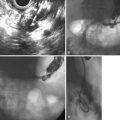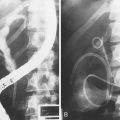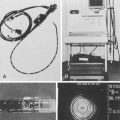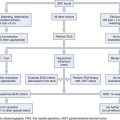Chapter 9 Reporting, Documentation, and Risk Management
Introduction
Endoscopic services have developed rapidly over the past 30 years such that the practice of gastroenterology is a procedural specialty for most practitioners. Procedural activities carry specific risks to the patient and expose the gastroenterologist to more potential for litigation than many other physicians; this is particularly the case because most procedures are performed on “the walking well”—patients without a defined major illness who have little expectation of a poor outcome (e.g., compared with cardiologists performing infarct angioplasty). Despite this increased potential for litigation, a review of medical claims in the United States ranked gastroenterologists 23rd of 28 specialties in number of claims.1
Relationship of Medical Practice to Litigation
Several large studies have examined the impact of medical error on patient care.2–5 Up to 36% of hospital admissions are associated with some form of error during the admission, usually trivial and of no clinical impact. However, a study of 20,000 surgical admissions noted an iatrogenic disability rate of 4.6%. Most of these disabilities were attributable to “acceptable risk,” but the authors concluded that 17% of these injuries would have probably been successfully litigated. In other words, almost 1% of surgical admissions could result in a successful lawsuit against the surgeon. In the Harvard Medical Practice Study,4 less than 2% of patients with an iatrogenic injury filed a claim. Other factors in addition to injury determine whether a claim is filed. Several studies have addressed this issue and found that major determinants of a patient’s decision whether to sue are patient dissatisfaction and the physician’s communicative and interpersonal skills.6–9
Claims against Gastroenterologists
Data regarding claims against gastroenterologists are difficult to assess because not all insurers are equally forthcoming with their data, and some major U.S. institutions self-insure and do not release their data for review. The Physician Insurers Association of America pools information from 20 member insurers and periodically publishes their data.1 These data have also been reviewed and published in the gastrointestinal (GI) literature.10,11 The claims fall into the following groups:
Specific Endoscopic Procedures
In the study by Gerstenberger10,12 of 610 endoscopic claims, the relative risk of litigation arising from various procedures (relative to sigmoidoscopy) varied by less than a factor of 2, as follows: sigmoidoscopy, 1.0; gastroscopy, 1.2; colonoscopy, 1.7; and endoscopic retrograde cholangiopancreatography (ERCP), 1.6. This small variation occurred despite the fact that ERCP and colonoscopy result in far more complications than sigmoidoscopy and gastroscopy. This seeming paradox is probably explained by the use of more intensive informed consent processes for ERCP and colonoscopy compared with the technically less challenging procedures. This study illustrates the important principle of informed consent as a risk management strategy (see later).
Legal Principles in Medical Practice
Principles of Tort Law
Tort law (with respect to medical negligence) involves four steps, as follows:
Breach of Duty
In a breach of duty, the physician failed to provide a reasonable standard of care after entering into the physician-patient relationship. This reasonable standard is often difficult to define and usually is established with the aid of expert witnesses—not to the level of an emeritus professor in that field but to a level acceptable to the physician’s peers (i.e., sound medical practice; published guidelines can be useful in this context but ironically are more often used for the plaintiff’s case). Many societies (e.g., American Society for Gastrointestinal Endoscopy [ASGE], British Society of Gastroenterology, and Gastroenterology Society of Australia) publish guidelines for endoscopic practice. The set of guidelines published by the ASGE, in particular, is an excellent resource that is available on the Internet (Box 9.1). Medical practice often varies depending on many variables, such as comorbidities, patient wishes, physician expertise, and available resources. If one deviates substantially from common practice, it is essential to note the reasons for this in the medical record.
Box 9.1 Professional Gastroenterology Societies
| American Gastroenterology Association | www.gastro.org |
| American Society for Gastrointestinal Endoscopy | www.asge.org |
| American College of Gastroenterology | www.acg.org |
| British Society of Gastroenterology | www.bsg.org.uk |
| Gastroenterology Society of Australia | www.gesa.org.au |
| World Gastroenterology Organization | www.worldgastroenterology.org |
Standards of Care
Standards of care is a legal concept that attempts to determine the duty physicians must fulfill in their care of a patient. Failure to practice to this standard constitutes a breach of duty. The court usually determines this standard by hearing expert testimony and relying on published data, such as peer-reviewed journal articles and practice guidelines.13,14 The standard is tailored to the specific case under review and should reflect current practice at the time of the injury. Although society practice guidelines and publications may be an important part of the evidence used to help determine this standard, they do not replace the court’s or jury’s determination in a particular case. Similarly, a case’s judgment is not designed to dictate future clinical practice (although this often is the case). The standard of care is best described as good patient care. It is not defined as best medical practice (e.g., that provided by a world leader in a field) but rather what would be expected from a peer under the same circumstances.
Defining Responsibility
Informed Consent
Informed consent comprises several elements, as follows:
The standard of disclosure presents difficulty with regard to all these elements. Traditionally, the professional standard of disclosure has been used. This standard may be defined as “as much information as would have been provided by a physician’s peers in the same situation”16 and was defined by a landmark case in 1960. It assumes that the physician is acting in the best interest of the patient. However, it was noted in the 1970s that this standard implies a paternalistic physician-patient relationship, which impinges on the patient’s right to self-determination. The lay or patient-oriented standard subsequently evolved. This standard was first enunciated in 1972, when a judge commented that “… a risk is thus material when a reasonable person, in what the physician knows or should know to be the patient’s position, would be likely to attach significance to the risk or cluster of risks in deciding whether or not to forego the proposed therapy.”17
It is important for the physician to avoid coercion of any sort. The physician should not be judgmental or emotive when explaining the procedure or the consequences of not following medical advice. It has been proposed by some authorities that obtaining informed consent in the endoscopy room immediately before the procedure could be perceived as being coercive because the patient, having taken time off work and being prepared, gowned, and possibly with an intravenous line in situ, is unlikely to refuse the procedure. Also, the endoscopy suite environment is unlikely to provide the patient with an adequate opportunity to ask questions. These issues are especially important in the setting of open-access endoscopy. Informed consent must be obtained in the language suitable to the patient’s comprehension. If the patient speaks only a foreign language, consent should be obtained though a health care professional fluent in the language or interpreter service. A friend or relative of the patient should not act as interpreter because this may constitute a breach of confidentiality, and the patient may be misled by the friend or relative’s own biases about what he or she wishes the patient to hear. In one study, a videotape discussing the proposed procedure was shown to patients and was found to be as useful as discussion with the physician without the tape. If information tapes are used, there must be the opportunity for the patient to ask questions that might arise from the viewing.18
Documentation
Sound documentation is an important risk management tool and a component of good medical practice. Nothing in a patient’s management plan should be left to the memory of the physician. A case may come to trial years after the event. It is highly unlikely that the physician would be able to remember details of a consultation with the clarity of the plaintiff (on whom this brief physician-patient interaction has had a major impact). The plaintiff would appear to be a much more credible witness unless the physician has comprehensive notes. Generally, a court would accept that something was discussed or did occur if it was documented in the notes at the time. Conversely, a court or jury may decide that a conversation did not occur if the plaintiff denies it and the physician only “remembers” the conversation or states that it is always his or her practice to discuss a certain aspect of care. Videotaping the consent process has been mentioned as a method of documenting exactly what occurred.19
Risk Management
Many of the issues already discussed constitute important aspects of risk management:
Quality Agenda in Endoscopy
Specific Quality Indicators in Endoscopy
National and international endoscopy bodies, such as the American Society of Gastrointestinal Endoscopy, American College of Gastroenterology, World Gastroenterology Organization, British Society of Gastroenterology, and Gastroenterology Society of Australia, have published guidelines on quality indicators related to various aspects of endoscopy (see Box 9.1). Objective procedural quality indicators have been suggested by ASGE21 for colonoscopy and for ERCP:
 Colonoscopy
Colonoscopy
Such guidelines are designed to help ensure appropriate, safe, and cost-effective endoscopic practice and should help assist endoscopists and endoscopy units in establishing quality criteria in monitoring their activities. The increasing use of computerized reporting systems should make data capture for the purposes of quality audits (individual and institutional) easier in the future. Photographic documentation, especially of colon landmarks, is increasingly recommended. Sedation-related issues are also being recognized as an important aspect of quality endoscopic practice.23 As risks associated with sedation are being recognized and guidelines regarding appropriate care are disseminated, endoscopists and endoscopy units will need to monitor their experience in this aspect of endoscopic practice.
1 A risk management review of malpractice claims: Gastroenterology. Available from Research Department, Physician Insurers Association of America, Rockville, MD 20850 (summary report published 2000).
2 Brennan TA, Leape L, Laird N, et al. Incidence of adverse events and negligence in hospitalized patients. N Engl J Med. 1991;324:370-376.
3 Leape L, Brennan TA, Laird N, et al. The nature of adverse events in hospitalized patients: results of the Harvard Malpractice Study II. N Engl J Med. 1991;324:377-384.
4 Localio RA, Lawthers AG, Brennan TA. Relationship between malpractice claims and adverse events due to negligence. N Engl J Med. 1991;325:245-251.
5 Brennan TA, Sox CM, Burstin HR. Relationship between negligent adverse events and the outcomes of medical malpractice. N Engl J Med. 1996;335:1963-1967.
6 Hickson GB, Clayton EW, Entman SS, et al. Obstetricians’ prior malpractice experience and patients’ satisfaction with care. JAMA. 1994;272:1583-1587.
7 Hickson GB, Federspiel CF, Pichert JW, et al. Patient complaints and malpractice risk. JAMA. 2002;287:2951-2957.
8 Levinson W, Roter DL, Mullooly JP, et al. Physician-patient communication: the relationship with malpractice claims among primary care physicians and surgeons. JAMA. 1997;277:553-559.
9 Hickson GB, Clayton EW, Githens PB, et al. Factors that prompted families to file medical malpractice claims following perinatal injuries. JAMA. 1992;267:1359-1363.
10 Gerstenberger PD, Plumeri PA. Malpractice claims in gastrointestinal endoscopy: analysis of an insurance industry database. Gastrointest Endosc. 1993;39:132-138.
11 American Society for Gastrointestinal Endoscopy: Medical malpractice claims and risk management in gastroenterology and gastrointestinal endoscopy. 2002.
12 Gerstenberger PD. Malpractice in gastrointestinal endoscopy. Gastrointest Endosc Clin N Am. 1995;5:375-389.
13 Mello MM. Of swords and shields: the use of clinical practice guidelines in medical malpractice litigation. Univ Penn Law Rev. 2000;149:645-710.
14 Hyams AL, Shapiro DW, Brennan TA. Medical practice guidelines in malpractice litigation: an early retrospective. J Health Polit Policy Law. 1996;21:289-313.
15 Dunham v Wright, 423 F2d 940, 946 (3d Cir 1970).
16 Natanson v Klein, 186 Kan 393, 350 P2d 1093, reh’g denied, 187 Kan 186, 354 P2d 670 (1960).
18 Agre P, Kurtz RC, Krause BJ. A randomized trial using videotape to present consent information for colonoscopy. Gastrointest Endosc. 1994;40:271-276.
19 Plumeri PA. Informed consent for gastrointestinal endoscopy in the ’90s and beyond. Gastrointest Endosc. 1994;40:379.
20 Bowles CJ, Leicester R, Romaya C, et al. A prospective study of colonoscopy practice in the UK today: are we adequately prepared for national colorectal cancer screening tomorrow? Gut. 2004;53:277-283.
21 Cotton PB. Analysis of 59 ERCP lawsuits: mainly about indications. Gastrointest Endosc. 2006;63:378-382. quiz 464
22 ASGE: Measuring the quality of endoscopy. Gastrointest Endosc. 2006;63(Suppl 4):S1-S38.
23 Melloni C. Anesthesia and sedation outside the operating room: how to prevent risk and maintain good quality. Curr Opin Anaesthesiol. 2007;20:513-519.














